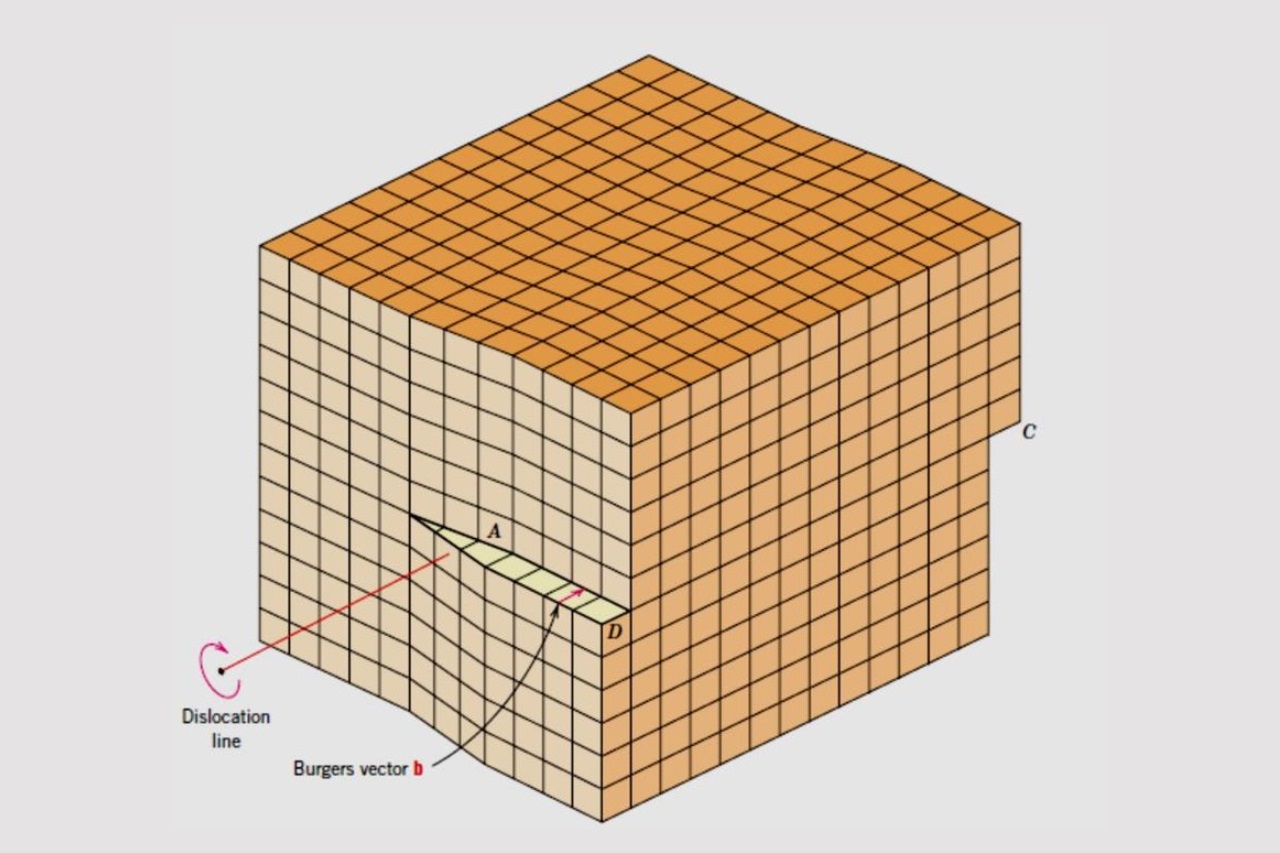
When it comes to understanding the intricate world of materials, one aspect that often captures attention is screw dislocation. This fascinating phenomenon has a significant impact on the mechanical properties and behavior of materials. Screw dislocation occurs when crystal planes are disrupted, causing a helical distortion in the lattice structure, which can lead to various interesting effects. In this article, we will explore 15 intriguing facts about screw dislocation that will not only deepen your knowledge of materials science but also pique your curiosity about the hidden intricacies of the atomic world. So, join us as we unravel the mysteries behind screw dislocation and delve into the captivating world of crystal defects.
Key Takeaways:
- Screw dislocations are like tiny defects in the structure of materials, and they play a big role in how materials bend and break under stress.
- By understanding screw dislocations, scientists can make stronger materials and prevent them from breaking, helping to create safer products for everyone.
What is a Screw Dislocation?
A screw dislocation is a type of linear defect in the crystal lattice structure of a material. It occurs when one part of the crystal lattice is displaced along a particular axis, creating a spiral or helical defect in the lattice.
Screw Dislocation Types
There are two main types of screw dislocations: edge dislocations and screw dislocations. Edge dislocations occur when the lattice is displaced along a direction perpendicular to the dislocation line, while screw dislocations result from a parallel displacement along the dislocation line itself.
Role in Material Strength
Screw dislocations play a crucial role in determining the mechanical properties of materials. They can affect the strength, ductility, and fracture behavior of a material, depending on their density, arrangement, and interaction with other defects.
Movement of Screw Dislocations
Screw dislocations can move through material under an applied stress. The movement is facilitated by the continuous shear deformation of the atomic planes along the dislocation line.
Crystallographic Slip
Screw dislocations are closely associated with crystallographic slip, which refers to the sliding of atomic planes past one another. This slip is responsible for the plastic deformation and shape change in materials under stress.
Dislocation Motion and Plasticity
Screw dislocations are primarily responsible for the plastic deformation of materials. Their motion, along with the motion of other dislocations, allows materials to exhibit plasticity and undergo permanent deformation without fracturing.
Stress Concentration
Screw dislocations can cause stress concentration regions known as pile-ups. These regions can have a significant impact on the material’s mechanical properties and can contribute to the initiation of cracks and fractures.
Interaction with other Defects
Screw dislocations can interact with other defects such as vacancies and impurities. These interactions can influence the material’s behavior under different conditions, altering its mechanical, electrical, or thermal properties.
Screw Dislocation Formation
Screw dislocations can form during the manufacturing process or as a result of external forces applied to a material. They can be introduced intentionally through processes like cold working or arise naturally due to thermal stresses or deformation.
Screw Dislocation and Crystal Growth
Screw dislocations can also influence the growth of crystals. They can act as nucleation sites, promoting the formation of new crystal structures or influencing the orientation of crystalline domains.
Role in High-Temperature Deformation
Screw dislocations play a crucial role in high-temperature deformation processes such as creep. They can facilitate the motion of dislocations and contribute to the material’s ability to undergo plastic deformation at elevated temperatures.
Studying Screw Dislocations
The study of screw dislocations is vital for understanding the behavior of materials under different conditions. Various techniques, including transmission electron microscopy and X-ray diffraction, are used to visualize and analyze the structure and motion of screw dislocations.
Screw Dislocations in Metals
Screw dislocations are common in metallic materials, where their presence can significantly affect the material’s mechanical properties. Understanding the behavior of screw dislocations is particularly important in fields such as materials science and metallurgy.
Screw Dislocation and Strengthening Mechanisms
The interaction between screw dislocations and other strengthening mechanisms, such as grain boundaries and precipitates, determines the overall strength and toughness of materials. Manipulating the behavior of screw dislocations is key to developing stronger materials.
Screw Dislocations and Material Defects
Screw dislocations can both initiate and interact with various material defects, including cracks, dislocations, and grain boundaries. Understanding these interactions is crucial for predicting and preventing material failure.
Conclusion
Screw dislocations are a fascinating aspect of materials science and play a significant role in determining the mechanical properties of various materials. Understanding the behavior and characteristics of screw dislocations is crucial for designing and engineering more resilient and durable materials.In this article, we have explored 15 intriguing facts about screw dislocations. We have learned about their definition, formation, and how they contribute to plastic deformation in metals and crystals. We have also delved into their impact on material strength, their role in facilitating movement in dislocation creep, and the various techniques used to study and visualize screw dislocations.By unraveling the complexities of screw dislocations, researchers and engineers can develop new strategies to improve material properties, enhance manufacturing processes, and create more efficient and reliable technologies.As our understanding of screw dislocations continues to evolve, it opens up possibilities for groundbreaking advancements in fields ranging from aerospace engineering to nanotechnology. The knowledge gained from studying screw dislocations unlocks a world of opportunities for innovation and progress in material science.
FAQs
Q: What is a screw dislocation?
A: A screw dislocation is a type of defect in a crystal lattice where a shear deformation occurs along a specific atomic plane. It resembles the movement of a screw threading into a material.Q: How are screw dislocations formed?
A: Screw dislocations are formed when one part of a crystal lattice is displaced relative to another along a shear plane. This displacement causes a misalignment of the lattice structure, leading to the creation of a screw dislocation.Q: What is the role of screw dislocations in material strength?
A: Screw dislocations can impact material strength by impeding the movement of other dislocations within the material. They create resistance to deformation and contribute to a material’s overall hardness and strength.Q: How do screw dislocations facilitate movement in dislocation creep?
A: Screw dislocations can facilitate movement in dislocation creep by acting as channels for the flow of atoms. They provide a pathway for the material to deform plastically, allowing it to withstand high-temperature and high-stress conditions.Q: What techniques are used to study and visualize screw dislocations?
A: Various techniques are employed to study and visualize screw dislocations, including transmission electron microscopy (TEM), atomic force microscopy (AFM), and X-ray diffraction (XRD). These techniques enable scientists to observe and analyze the behavior of screw dislocations at a nanoscale level.
Screw dislocations play a crucial role in material properties, but they're just one aspect of the fascinating world of materials science. Delve deeper into materials science to uncover surprising facts that will change your perspective. Crystallography holds captivating secrets waiting to be revealed, from the intricate structures of crystals to their impact on various fields. For those interested in the world of metals, metallurgy offers extraordinary insights into the production, properties, and applications of these essential materials. Explore these topics to expand your knowledge and appreciate the complex beauty of the material world around us.
Was this page helpful?
Our commitment to delivering trustworthy and engaging content is at the heart of what we do. Each fact on our site is contributed by real users like you, bringing a wealth of diverse insights and information. To ensure the highest standards of accuracy and reliability, our dedicated editors meticulously review each submission. This process guarantees that the facts we share are not only fascinating but also credible. Trust in our commitment to quality and authenticity as you explore and learn with us.


